15 reasons to visit this unique country
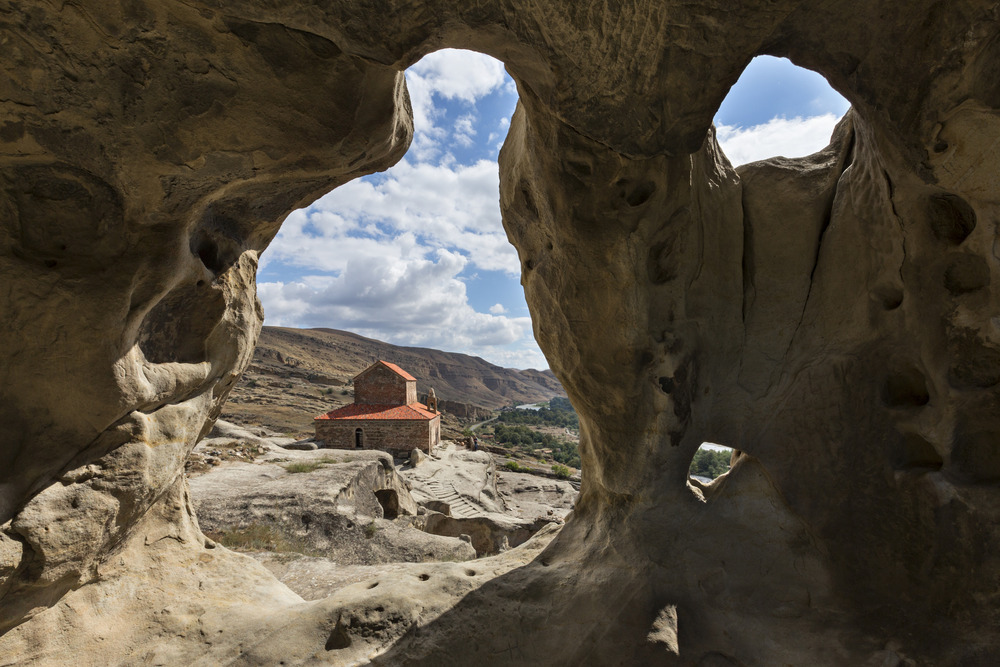
Monuments – Cities Carved out in Rocks
In Georgia there are about 35,000 historical monuments. On the examples of these monuments one can observe the whole evolutionary way of origin and development of cupola architecture, striking by its grandeur and monumentality, absence of superfluous massiveness.
Georgian architecture reached the peak of its development in 11-12th centuries. Three greatest cathedrals of Georgia from 11th century-Svetiskhoveli, Bagrati and Alaverdi-are certainly the sites that every tourist visiting Georgia must see. Monumental frescoes and paintings of the churches of the period are also unforgettably impressive.
Very popular are the palaces of Georgian kings and dukes, as well as the towns and monastery complexes carved in a rock: Uphliscikhe pre-Christian time; David Gareja and Vardzia located at the height of 1,300m.
UPHLISTSIKHE
This impressive and once enormous cave city is one of the oldest places of settlement in the Caucasus. It is located on the left bank of the river Mtkvari, 10 km to the east of Gori town.
Uphlistsikhe is the ancient name of the place used as the residence of the local rules which is evident by its name which is translated into “Residence of the Ruler” (“Uphali” in Georgian).
Uphlistsikhe was founded in the late Bronze Age, around 1000 B. C, but developed mainly from the 6th century B.C. to the 1st century A.D. This used to be the principal political and religious centers of pre-Christian Kartli Region, with temples dedicated principally to the sun goddess. Archeological findings from the 4th to 6th centuries A.D. speak of an ongoing struggle between Christians and adherents of the old religion.
What we visit today is the 40, 000 sq. m. ShidaKalaki, or Inner city, constituting less than half of the original whole. Almost everything here has been uncovered by archeologists since 1957, when only the tops of a few caves were visible.
The Uphlistsikhe cave complex has been on the tentative list for inclusion into the UNESCO World Heritage program since 2007.
VARDZIA
Vardzia (12th c.) is a city carved into the rock, a monastery-a Royal palace which was elevated by 100 meters and consisted of thirteen floors. Originally Varzia had 3, 000 rooms and a capacity for more than 3,000 people (365 of the rooms belonged to King Tamar). There were more than 600 storage rooms, kitchens, libraries, cells and auxiliary storages in addition to 25 wine-cellars with 185 pitchers, and more. Several floors of the complex are connected to each other by a labyrinth of tunnels.
The Vardzia complex has 15 churches. The most significant is the Saint Mary Cathedral, where wall paintings of biblical fragments are preserved along with the frescoes of King Tamar and her father-George III.
Over time, invasions and earthquakes destroyed a large part of the Vardzia Complex. Despite this fact, the complex still astonishes visitors with its subtlety and importance.
The Varzia cave collection is located 290 km away from Tbilisi, in the Samtskhe-Javakheti region.
DAVID GAREJA
On the border with Azerbaijan, Davit Garega is perhaps the most remarkable of all Georgia’s ancient sites, and the most interesting easy day trip from Tbilisi. It is a rock-hewn Georgian Orthodox Monastery Complex located in the Kakheti region of Easter Georgia, on the half-desert slopes of Mt. Gareja, some 60-7- km. southeast of Georgia’s capital Tbilisi.
In the 6th century, 13 Assyrian monks established the monastic life in Georgia and one of them, St. David from Gareja founded the GarejaLavra. Comprising about 15 old monasteries spread over a large, remote area, its uniqueness is heightened by a lunar, semi desert landscape which turns green and blooms with flowers in early summer. Two of the key monasteries and the most visited, are Lavra and on the hill above it, Udabno, which has beautiful frescoes.
A Soviet military base and firing range was constructed near the Davit Gareja Monastery. Due to intensive military training, the unique frescoes of the monastery were destroyed. However, the monastery still makes a huge impression on visitors.
Davit Gareja desert is the place where Shah Abbas killed 6000 monks on an Easter night in 1616.
Davit Gareji monasteries were multifunctional. Along with strengthening the Christian faith, they played an important role in the educational and cultural development on the country. Chroniclers served in these monasteries, theological literature was written, books were translated and collection were created.
The monastery remains active today and serves as a popular destination of tourism and pilgrims.
The Highest Caucasus Mountain Range of Europe
DENSE forests of precious fir trees, pines, larches and alpine meadows covered with edelweiss snow – this is Georgian Highland (Svaneti, Khevi, Tusheti, Mtiuleti, Pshavi-Khevsureti and Ratcha).
The difficulty of the terrain makes Georgia Highland one of the most remote and inaccessible regions of the world. High dwelling towers and fortress-houses create impressive complexes of villages. Deep canyons of rivers, narrow mountain paths, and mineral spa are little touched by civilization up to present time. Winter here lasts about eight months, with the lowest temperature -35 O C. Snow can be over three meters high and the roads often impossible to pass. June is the beginning of the season and a wonderful time to go. In summer the average temperature is 22 O C during the day and 8 O C at night. The sense of time warp, combined with the grandeur of the natural setting, makes trips there well worth the effort needed to overcome any difficulties you might encounter during your journey.
The harsh climate and mountainous landscapes are the principal factors behind the Highlanders’ character. They are proud, laconic people who find virtue in a certain austerity and stoicism. Hunters and alpinists are the most respected members of the community.
Georgian mountains give the chance of discoveries and exploration of the summits of more than 5,000 meters of height for the people who are fond of mountaineering. The most exciting mountains are Shkhara (5,068 m), Janga (5, 058 m), Mkinvartsveli or Kazbek (5, 047 m), ShotaRustaveli (4, 860 m), Tetnuldi (4, 858 m), Ushba (4, 700 m) and Ailama (4,547 m). Mountains in George have 1st -5th categories of difficulty UIAA. Most itineraries are rocky and some of them are very difficult. For example the easiest route to the one of the most beautiful mountains on the earth Ushba has 4th category of difficult UIAA.
Georgian highland is unique place for hiking and climbing. If you are searching for the unhampered spirit of the mountains, for the rhythms of a pastoral way of life, and expanses of nature as unsullied as on the day God created the Earth, then by all means.
SVANETI, western part of Georgian Highland is located near upper reaches of the river Enguri and comprises of two parts. Administration center of Upper Svaneti is Mestia and Lower Svaneti-Lentekhi. The highest village in Europe Ushguli (2, 200 m. above sea level) is, situated in Upper Svaneti. Villages in Svaneti have unique tower architecture.
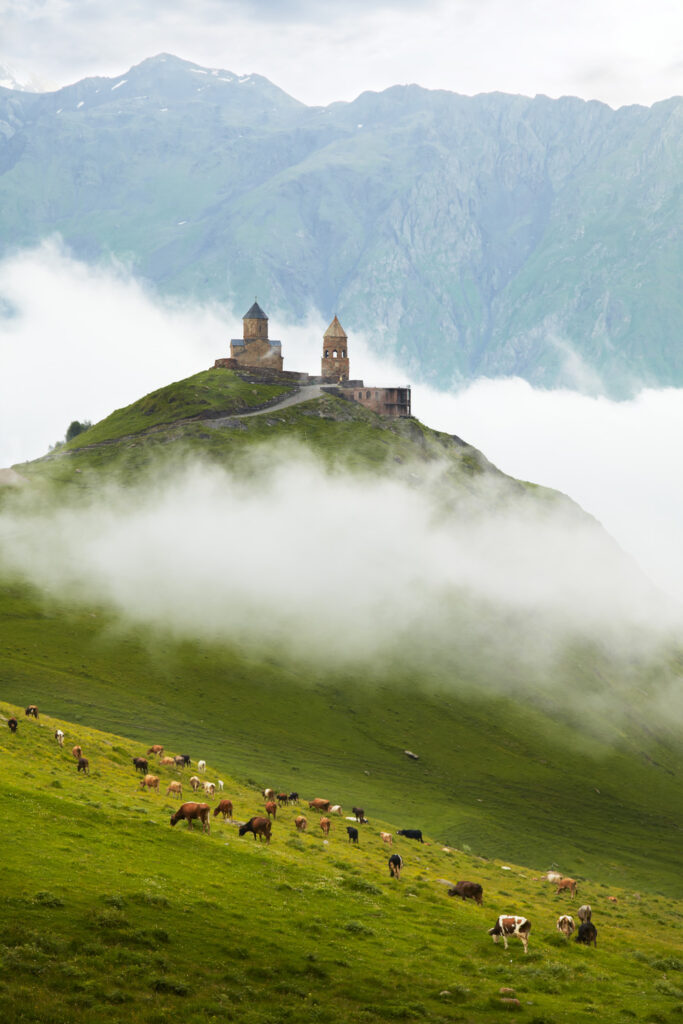
KHEVI, province situated along the northern part of Georgian Military Highway in the Tergi (Terek) River (Main River of the north Caucasus) Gorge. On both sides of famous canyon are original medieval monuments-watch towers that remind one of the grim and troubled past of the local people. Main town is Kazbegi, situated under mountain with the same name having the height of more than 5,000 m.
TUSHETI, is a historical region in north-east province of Georgiia. Main village is Omalo, the place of junction of four canyons. Untouched by civilization, stone houses and towers here are different from other mountain provinces. Tusheti is one of the fourth national reserves of Georgia. Its unique nature and ethno-cultural realities make it extraordinary attractive interesting. This most ancient highland region preserved rich traditions of the old original pastoral culture till the present day.
One of the most ecologically unspoiled regions in the Caucasus, Tusheti is a popular mountain trekking venue.
MTIULETI, is the province in central part of Georgian Highland along the Georgian Military Highland before crossing Cross Pass. Administrative center is Dusheti, situated not far from beautiful Bazaleti and Zhinvali Lakes. All rivers of Mtiuleti gather in the Aragvi River canyon running to the south from main Caucasus range.
PSHAVI-KHEVSURETI, province, one of the most picturesque and original spots in the central part of Georgian Highland, is situated in the upper reaches of the Aragvi River. Chargali is the main village of Pshavi. Vazha-Pshavela-the outstanding Georgian poet was born here. The main Caucasian range divides Khevsureti into two parts, Pirikiti with the center of Shatili and Pirakiti with the center of Barisakho. In the old villages houses cram one above another in a step-like manner. The roof of a houses is a yard for upper one.
RATCHA, is located around upper reaches of Rioni-the second longest river in Georgia. One can see the half of western Georgia from Mravaldzali-the highest village of this Province. Administrative center of Ratcha is Oni, the second biggest town-Ambrolauri.
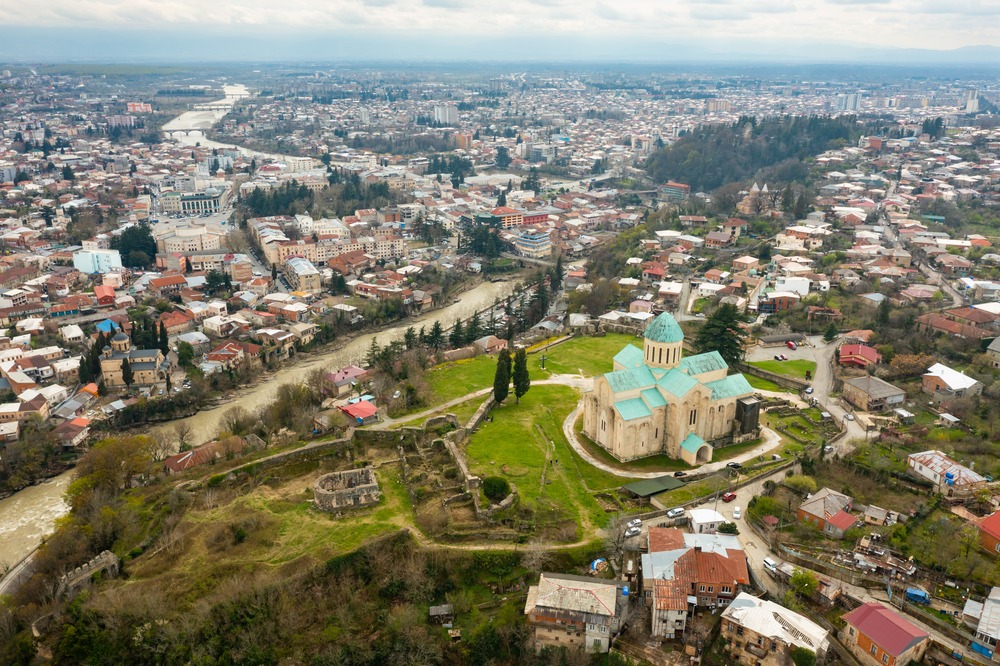
A Silk Road Country
The ancient great silk road caravansused to pass through Georgia along the centuries. They connected east and north to south and had significant cultural influence on Georgia. Thus, Georgia as a border between Europe and Asia linked these two parts of the world and was situated at the end of this road.
Greek and Roman historians, geographers and travelers who have travelled through Georgia have described these trade and transit routes in II-I centuries BC. According to Strabo and Plinius the road from the Middle Asia to the Caspian Sea went along the river Amu Darya, and from the Caspian Sea along the river Mkkvari (Kura). The traders sailed on this river through the eastern territories of Georgia, then crossed the Likhi range to the western Georgia and sailed along the river Phasis (Rioni) until they reached the city also named Phasis, from where their roads led to Rome, Constantinople and other large trade cities.
On the territory of Georgia the archaeologists have found the samples of silk in the tombs of 1st -2nd centuries B.C. Being a part of the Silk Road was very profitable, and for that reason Rome and Byzantium had continuous wars first with Persia and then with Iran. Influenced by wars and politics the route of the Silk Road changed. In the 7th century Byzantium lost Syria, and with it went the main suppliers of silk in the face of Syrian traders. Constant fight between the Muslims and Christians created favorable conditions for European traders with silk and Great Silk Road temporarily became their monopoly. In the 9th -10th centuries, Georgia lay on the trade and transit route that linked Eastern Asia and Arab countries with Eastern Europe, Scandinavia, and the Baltic Sea. The antique cave town of Uplistsikhe with more than 350 still existing caves was an important trade city lying on the rote. Still now it is well preserved and fascinates it’s visitors.
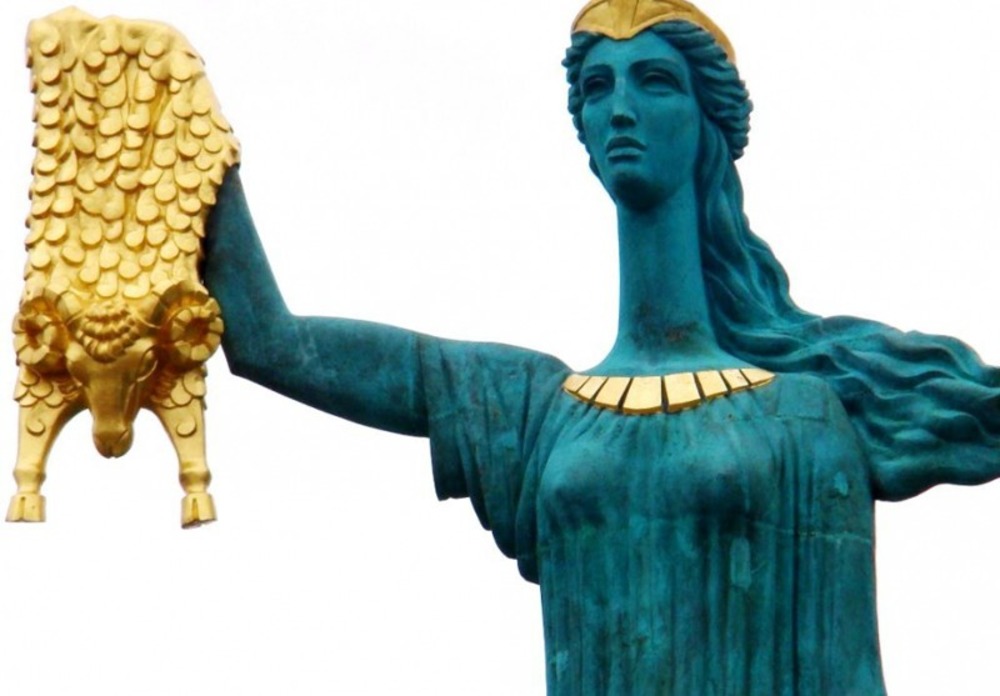
Mythology –A Golden Fleece
ARGONAUT’S VOYAGE 15 YEARS AGO
Indeed 15 years ago, in July 1984 Argonauts arrived in Georgia. Mew-Argonauts, sailed 1500 miles by the ancient Greek-style 20-oared galley from the myths to the nowadays.
We know from the legends that the heroes of the Greek Mythology headed by Jason in search of Golden Fleece visited Colchis. Colchis is the name of Georgia Black Sea Coast from ancient time. Modern “Argo” dropped anchor near the antique town Vani in Colchis Valley.
Tim Severin, the famous scientist and explorer was the head of the expedition. From 1976 he develops scientific-practical program named experimental archaeology with the aim of reconstruction of the history.
Crew of the new “Argo” consisted of 12 citizens of UK. However, 4 Greeks, 27 Turks and 10 Georgian volunteers have taken part in that extraordinary expedition when passing territorial waters of their own countries.
UNESCO World Heritage Sites of Georgia
Georgia joined UNESCO on 7 October, 1992.
- Mtskheta-the ancient Capital of Georgia –city-museum reserve (1994). Jvari Temple (6th century AD, Svetitskhoveli Cathedral (11th century AD).
- Gelati Architectural Complex (12th century AD)
- One of the most exotic corners of Georgia –Village Ushguli (1996)
- Georgian culture gives pride of place to popular song as typified by the Chakrulo, a polyphonic song using metaphors and complex musical ornamentation, whose medieval origin is linked to the cult of wine and winemaking. In 2001 UNESCO proclaimed Georgian Traditional Polyphony a masterpiece of the Oral and Intangible Cultural Heritage.
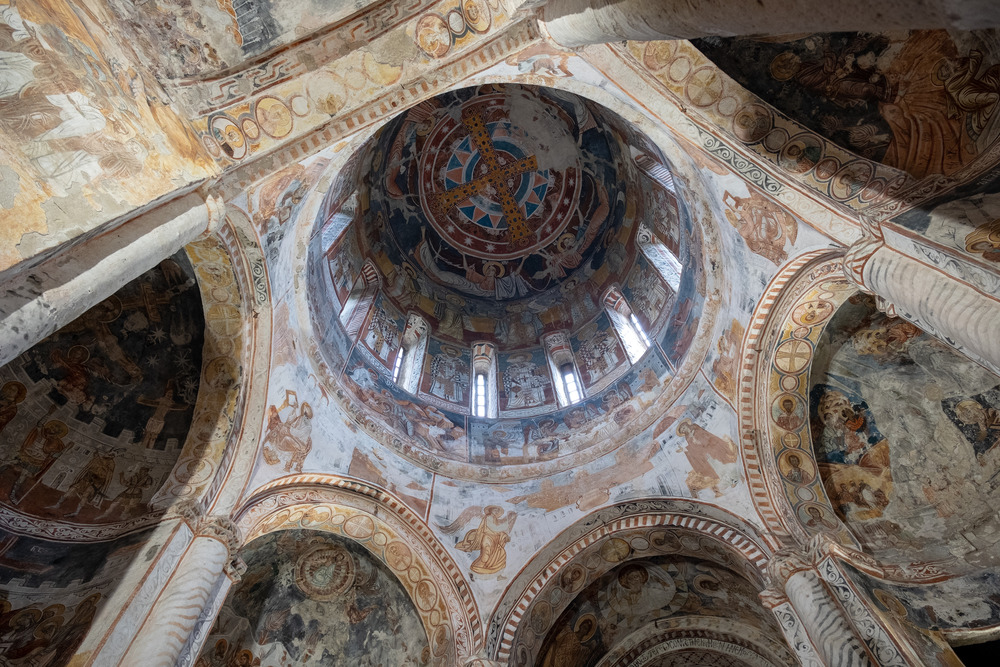
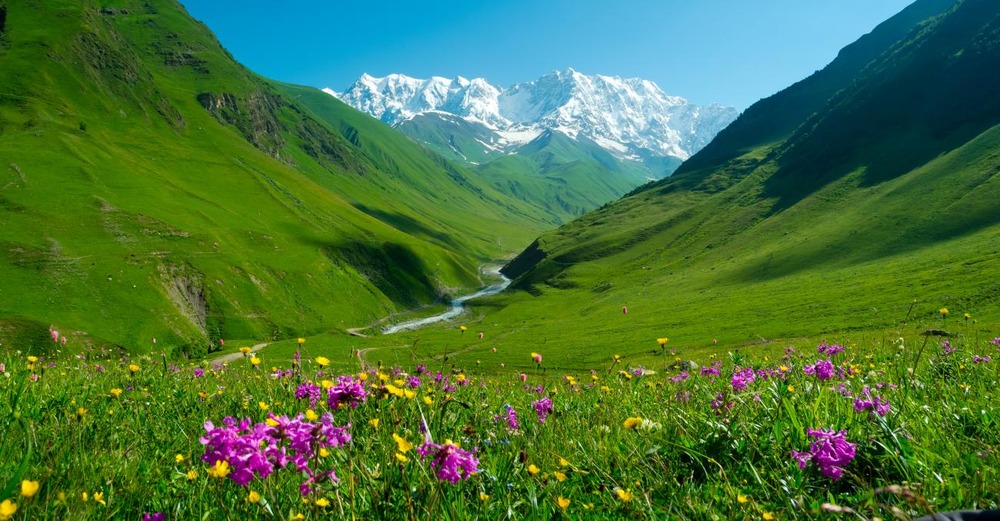
Geography of Georgia
Georgia is located to the east of the Black Sea and to the south of Great Caucasus Mountain Range. In the 41-43 latitude and 40-46 longitude. The region is known as the “South Caucasus” or “Transcaucasia” currently in Western languages. It shares borders with Russian Federation in the north, Turkey in the south-west, Armenia in the south, Azerbaijan in the south-east and the Black Sea in the west.
Two thirds of Georgian territory is occupied by mountains. The north of the country is occupied by the Greater Caucasus chain [highest point –Mt. Shkhara, 5068m], in the upper parts of the Caucasus Mountains there are 786 glaciers with the total area of 556 square kilometers. There are well known mountain passes which are used as tourist routes / Djvari [2384m], Mamision [2829m], Rocki [2996m].
Between the Great and the little Caucasus there is located a sublatitudial zone of intermountain basis where the most fertile soils of Georgia are concentrated. In the West the Kolkhida lowland is bordered by Loikhi {Surami} mountain ridge, which is a natural border between the East and West Georgia. On the East of Likhi Mountain ridge is located Kartli plain, Iori and Shiraki plateau, with altitude of 500-700m and Alazani valley {500m}.
HIGHEST MOUNTAINS
- Shkhara 5068 m (16, 627 ft)
- Janga 5059 m (16, 597 ft)
- Mkinvartsveri (Mt. Kazbegi) 5047 m (16, 558 ft)
- ShotaRustaveli 4860 m (15, 944 ft)
- Tetnuldi 4858 m (15, 419 ft)
- Ushba 4700 m (15, 419 ft)
- Ailama 4547 m (14, 917 ft)
Georgia is rich in inland waters, although the river network is distributed unevenly. From total of 25,075 rivers, 17,000 are situated in the Western part of Georgia. Most of the rivers belong to the Black Sea Basin and the other part belongs to the Caspian Sea basin. The longest river in West Georgia Rioni{327km} takes start at the Great Caucasus and flows into the Black Sea near Poti. The River Mtkvari takes start in the mountains of Turkey, crosses South and East Georgia and on the territory of Azerbaijan flows into the Caspian Sea. Most of the other rivers are relatively short, often no longer than 25km, and only sixteen of them range in length from 100 to 500 km.
LONGEST RIVERS
- Mtkvari (Kura in Russian) 1515 km (351km in Georgia)
- Tergi 623 km (391, 1 miles)
- Chorokhi 438 km (272,1 miles)
- Alazani 407 km (390 km in Georgia)
- Rioni 333 km
- Tori 320 km (198,8 miles)
- Enguri 215 km (132,3 miles)
There are 860 lakes in Georgia. Mostly small in size, they are situated in picturesque landscapes, surrounded by trees, both evergreen and deciduous. Especially numerous are fresh water lakes.
LARGEST LAKES
- Paravani 37,5 sq.km (14,4 sq ml)
- Kartsakhi 26,3 sq.km (10,1 sq ml)
- Javakheti plateau, on the Black Sea coast 18,2 sq.km (7,0 sq ml)
- Paliastomi, on the Black Sea coast 18,2 sq.km (7,0 sq ml)
- Tabatskuri 14,2 sq.km (5,4 sq ml)
- Khanchali 13,3 sq.km (5,1 sq ml)
- Jandari 10,6 sq.km (4,0 sq ml)
- Lake Ritsa, with average depth of 101 m, is the deepest
An important place among the tourist attraction belongs to more than 2,000 mineral water springs of all kinds. Mineral waters, which are distributed over the entire territory of Georgia, represent a truly valuable resource for the country. Naturally, chemical content of different springs varies, but they include waters rich in carbon, calcium, calcium chloride, natrium chloride, calcium and natriumhydrocarbonate. They are: Borjomi, Utsera, Dzau, Nabeglavi, Sairme, Zvare, Nunisi etc.
Georgia is also rich with medicinal dirt.
Georgia-One of the first Christian Country
Georgia’s Christian history goes back to the 1st century AD, when the land was visited by the Apostles Simon and Andrew. it is believed that a Georgian Jew from Mtskheta, Elias, who witnessed Christ’s crucification at Golgotha, brought Christ’s Robe back in Georgia and it is buried in Svetitskhoveli Cathedral in Mtskheta, a UNESCO World Heritage site. Georgia became the third country in the world to adpot Christianity in 337 AD. The conversion of Kartli to Christianity is credited to a Greek women, St. Nino of Cappadocia. Georgians remained Christian despite ongoing invasions by Muslim powers and long episodes of foreign domination.
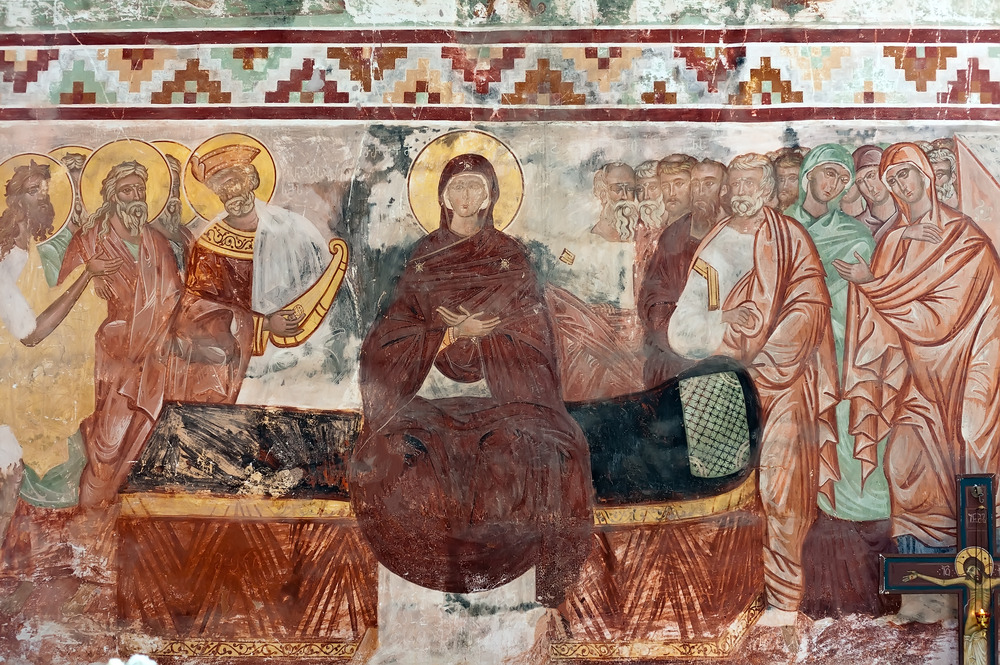
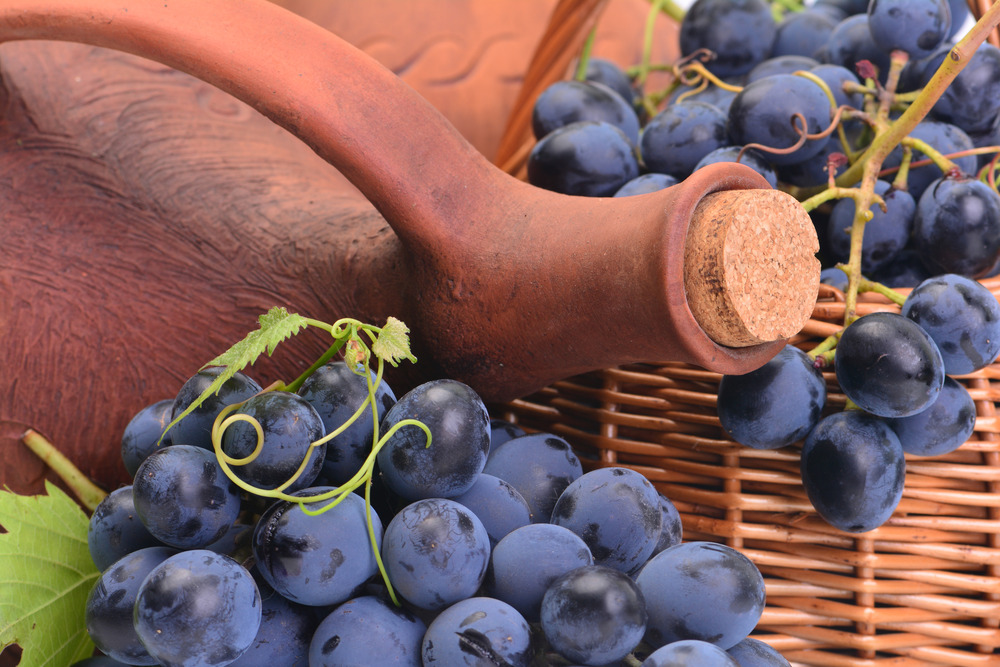
GEORGIA- The Cradle of Wine
For a Georgian the wine is a mystical, divine liquid. Vinaceous culture is an ancestry of the national formation. Georgia is often called “The Wine Cradle”. Vineyard has been there for centuries, and the centuries give a mystical tint to anything.
Vine used to associate with the symbol of Georgia and its pride since ancient times. The fact of worshiping wine, as a holy drink can be met in Georgia yet in the second millennium before Christ.
Fertile ground, favorable climate, efforts and devoted love of hard-working people preserved over 500 species and varieties of aboriginal Georgian vine. Among these species there are such worlds famous as Saperavi, Aleandrouli, Odjaleshi, Rkatsiteli, Usakhelouri, Mtsvane, Chkhaveri, Aladasturi, Tsolikauri, Krakhuna, Tsitska. Famous brands of Georgian wines are made of these grape varieties -Mukuzani, Khvanchkara, Tsinandali, Napareuli, Kindzmarauli, Barakoni, which favor success at many world exhibitions and are awarded with numerous gold and silver medals.
From the distance of ages up to now the vintage used to be a king of celebration, which included a number of rituals and preparation for it was usually beginning earlier enough. Before setting up the vintage people used to get occupied firstly with washing of traditional earthenware jugs, which we call Kvevri, and put order in wine cellars, which we call in our language -Marani. “In the belief and consciousness of Georgian people there rigidly dwelt worshiping to the vine tree and wine, like to that of saint icon and juice. Grapes and grape’s juice were regarding as a subject of contribution. Saint was as well a vessel, where juice of grapes was kept-which is Kvevri and Marani itself”. Thus, since those earlier times Marani was considered to be a place of worship. Meanwhile the wine and Kvevri were widely acknowledged as subjects of contribution. Making wine in ‘Kvevri’-a clay vessel dug in the groung-is a uniquely Georgian tradition recognised as UNESCO’s intangible Cultural Heritage.
After the gathering of grapes and crushing there are a series of works to be done: tidy up of Marani, supervision to fermentation of wine in jugs, storage of grapes selected for table, cooking of grape’s juice for preparation of traditional sweets with flour called-Tatara, preparation of Tatara for traditional sweets with nuts and hazelnuts called-Churchkhela, decant of wine and many others.
This is the way people in Georgia used to celebrate vintage in the past, which traditions survived up to now.
*Chkha-a branch of vine with two bunches of grapes on it.
*Akido-massive branches of vine consisting from several Chkha.
GEORGIAN WINE BRANDS
Dry wines for supra: Tsinandali (white), Gurjaani (white), Napareuli (white), Bakhtrioni (white), Manavi (white), Vazisubani (white), Tsitska (white), Tsolikauri (white), Rkatsiteli (white), Tibaani(white), Telavi (white), Sviri (white), Sameba (white), Teliani (red), Napareuli (red), Kvareli (red), Mukuzani (red) Dry ordinary wines for supra: Hereti (white), Gareji (white), Gelati (white), Kakheti (white), Dimi (white), Bodbe (white), Shuamta (white), Saperavi (red). Semi-Dray wines: Aguna (white), Sachino (red), Mtatsminda (red), Anakopia (white), Tbilisuri (white), Pirosmani (red), Barakoni (red) Semi –Sweet wines: Akhmeta (white), Tvishi (white), Tetra (white), Ckhaveri (white), Savane (white), Psou (white), AlaznisVeli (white), Khvanchkara (red), Ojaleshi (red), Kindzmarauli (red), Akhasheni (red), Tavkveri (red), Usakhelauri (red), Apsni (red), Lisni (red), AlaznisVeli (red), Aladasturi (red) Hard wines: Kardanakhi (white), Anaga (white), Sighnaghi (white), Iveria (white), Kolkheti (red), Taribana (white), Lelo (white), Marabda (white). Dessert wines: Saamo (white), Khikhvi (white), Salkhino (red), Bouquet from Abkhazia (white)
NATURE – Flora and Fauna
Nature is generously rich in Georgia. One can hardly find many places in the whole world that may hold such diverse landscapes within such a small area-from humid subtropics to perennial shows and glaciers of high mountains.
According to the words of Dr. Mikhail Zukov, “Not a single country of Europe has such flora and fauna as Georgia. Not in a single country of Europe can see such versatile relief on such a small territory. At the same time in Europe it is impossible to find a country preserved in such an original shape”.
The vegetation of Georgia is extremely rich and diverse, with numerous relic and endemic plants (dioskeria, pontic and Caucasian rhododendron, boxtree, common laurel-cherry, zelkva, persimmon, etc.). Forests cover over 1/3 of the area. In order to preserve the nature of the country 19 reserves have been organized. The largest of them are lagodekhi, Borjomi and Ritza State Reserves. The vegetation of Georgia is both abundant and diverse. Although Georgia’s territory is relatively small, there is a wide variety in the nature of plant life. At one extreme there are the plants of eastern Georgia’s dry semi-desert and mountainous regions, at another there are the thick humid woods that flourish in the subtropical climate of Kolhis. In addition, there are some peculiar plants in the highlands where severe climate prevails.
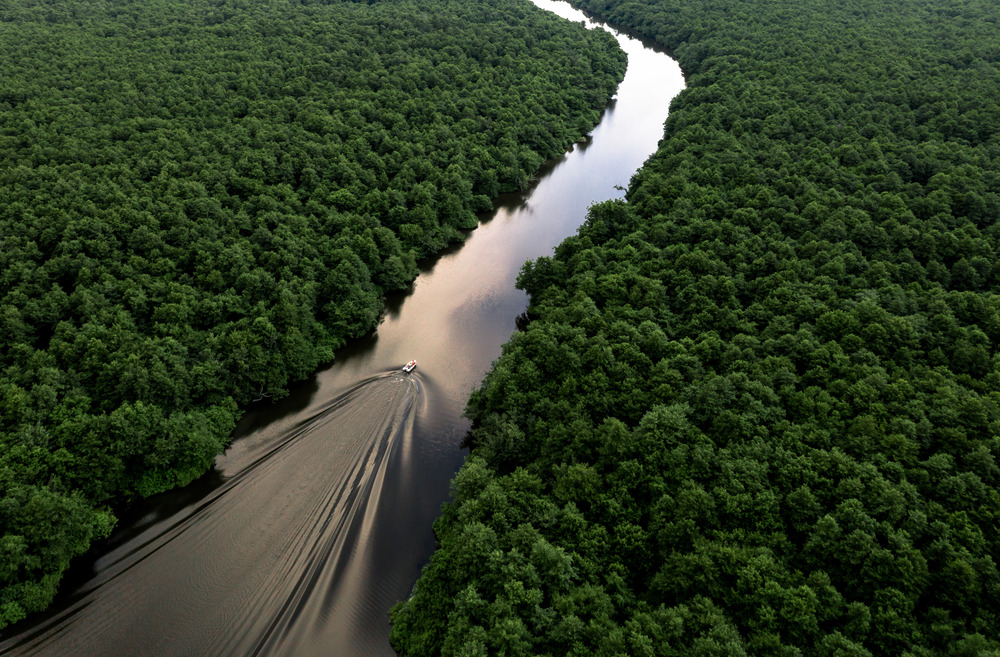
An index of the botanical diversity of the country shows that there are about 5, 000 varieties of wild or semi wild angiosperm and gymnosperm, as well as about 8, 300 kinds of cryptogamous plants (including 75 variety of filices, 600 of moss, 500 of mushrooms, and 2000 of aquatic plants) growing in Georgia.
The fauna of Georgia is also notable for its diversity. About 100 species of mammals have been recorded in Georgia and more than 330 species of birds, 48 of reptiles, 11 of amphibians, 160 different kinds of fish and thousands of invertebrates. Thus, in the woods and rivers of Georgia one can meet brown bear, wide-boar, wild cat, otter, marten, pheasant, quail, dolphin, cheat-fish, trout, salmon, Colchian sturgeon, carp and others.
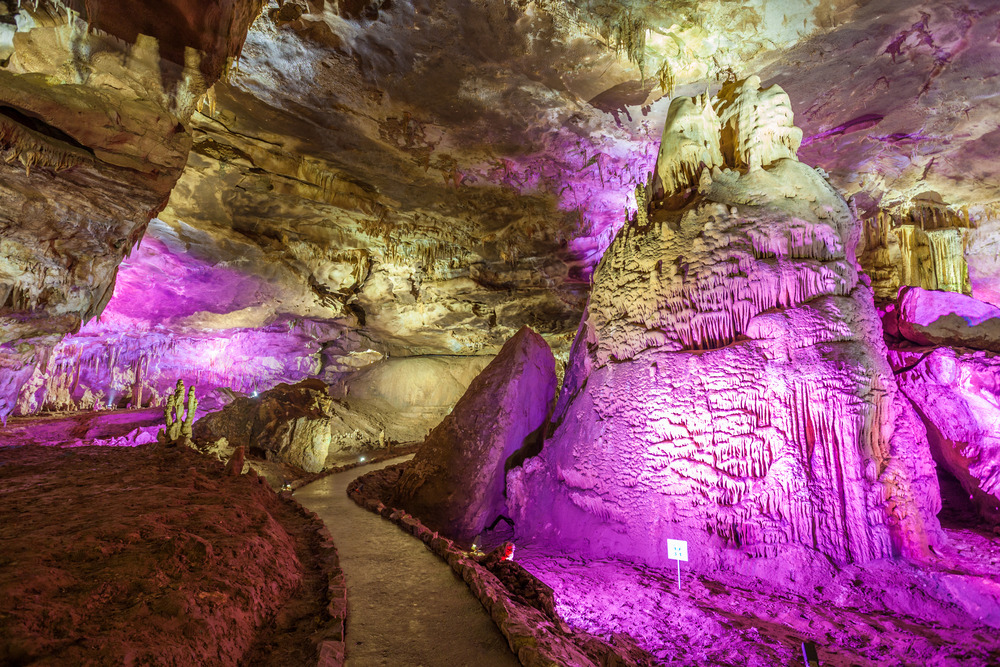
Speleology
It is not accident that Georgia is called the country of caves. The karst line of the area of more than 5,000 square km is stretched for three hundred kilometers along the south slope of Caucasus Mountains.
Today there are more than 1,100 caves, mines and canyons registered in Georgia, some of which are monuments of international significance. Napra-Mchishta is the deepest hydro-geological system on this planet-2, 345 m. Sensational Speleological findings are expected to be made in Mchishta basin! Pantiukhin canyon is on the third place in the world-1, 508m. Tovliani, IIiukhini and other canyons are more than 1, 000 m. Long.
Cave of New Athon discovered and explored by the institute of Geography for many years was on one of the first places in the world according to the number of visitors.
Among the karst regions of Georgia one of the most interesting is the Tskaltubo massive.
About Seventy years ago a famous naturalist PetreChabukiani discovered here a cave that up to day has been visited by more than two million people. He also discovered numerous footprints of the extinct reptiles-dinosaurs on the ancient layers of limestone, the age of which is 120 million years. On the basis of those monuments a famous Sataphlia National Park was founded which attracts enormous number of visitors.
There was a lot of discussion around the findings of 1984. Speleologists have discovered a cave near the famous resort Tskaltubo, which turned out to be wonderful monument of nature; it is richly decorated with melted shapes. The length of the cave is 15 kilometers.
The scientists have studied the air of the Tskaltubo cave. Research results proved that the microclimate of this cave by its medical features is close to the microclimates of such famous caves as Clutert (Germany) and Topolze (Hungury)
Georgian speleologists have discovered many caves on the slopes of Racha and Askhi Mountains. Toba cave system in Abasha is especially interesting.
Speleologists have vast contacts with their foreign colleagues. In the last few year’s speleologists from Czech Republic, Slovakia, Russia, Italy, France and other countries visited Georgia.
Languarge & Treasure
The history of the state of Georgia is over 2500 years old and Georgian is one of the oldest living languages in the world. Georgian Alphabet is among the 14 existing alphabets in the world. Mkhedruli, the script for modern Georgian, consists of 33 symbols (5 vowels and 28 consonants) where each sound has its corresponding symbol and vice verse. The Georgian letters is absolutely unique and cannot be compared to any other alphabet.
A-ა,B-ბ,G-გ,D-დ, E-ე, V-ვ, Z-ზ, TH-ტ, I-ი,K-კ,L–ლ,M-მ,N-ნ, O-ო,P-პ, ZH-ჟ,R-რ,S-ს,T-თ,
U-უ, PH-ფ, Q-ქ,GH-ღ, GHK-ყ, SH-შ, CH-ჩ, TS-ც, DZ-ძ, TZ-წ, TCH-ჭ, KH-ხ, J-ჯ, H-ჰ.
The most ancient Georgian script available made by stone inlaying, was found in the Judean desert in Palestine and is dated by 433 AD.
The first known monument of original Georgian Literature is The Martyrdom of St. Shushanik by Jacob Tsurtaveli written in the 5th c. By this time the Bible had already been translated into Georgian.
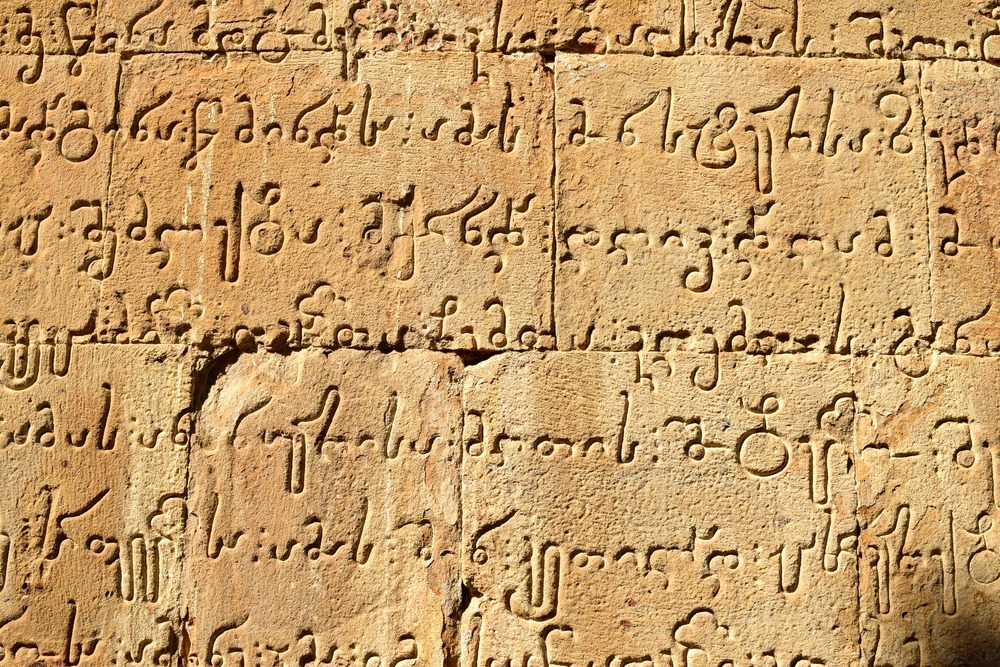
The oldest manuscript was discovered in St. Catherine’s Monastery on the Mount Sinai (Egypt) and is dated by 854 AD.
In the 12th c, which is known as the Golden Age of Georgian history, poet and philosopher of genius ShotaRustaveli wrote an unfading masterpiece “The knight in the Tiger’s Skin”. This poem, regarded by authorities as a precursor of the European renaissance, was translated into many languages.
The first Georgian printed book, Georgian-Italian Dictionary was issued in 1629 in Rome. The first Georgian- Printing House was established in Tbilisi in 1709.
Among the places to visit museums of Georgia deserve special attention. From 150 museums the most popular tourist attractions are the museum of S. Janashia and the Museum of Fine Arts of Georgia. Both of them have the treasure-houses of gold fund of Georgia. The golden handicrafts dating from second millennium to A.D. are exhibited there, including the jewellery up to the 19th century. Each region has a Museum of local history. In Tbilisi there is the Museum of National Architecture and life, recreating the way of life of our ancestors. Tourist sightseeing programs include visits to the pantheons, memorial houses of outstanding statesmen of Georgia, etc.
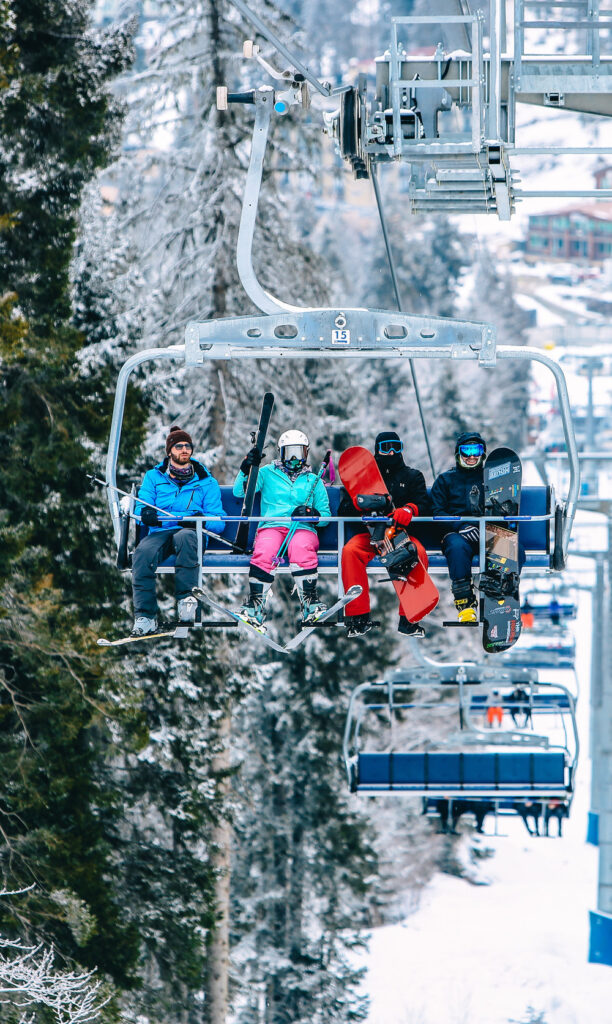
Four Season Resorts of Georgia
The major part of the Georgian resorts is accumulated on the Black Sea shores or in the mountains. Georgian mountains are known for beautiful landscapes, healthy climate, numerous mineral water springs and excellent skiing opportunities. Some of the most popular among them are: Borjomi, Sairme, Utsera, Surami, Abastumani, Tsemi, Java, Kojori, Kiketi, Manglisi, Bakuriani, Gudauri and others, which have a vast experience in successful treatment of such diseases as rheumatism, bronchial asthma, vascular and gynecological disorders.
The Black Sea attracts tourists by its subtropical climate, with moderate winters and continuous hot summers. In such sea resorts as Gagra, Sukhumi, Batumi, Kobuleti, Makhinjauri, Ureki, Sarfi and others season for bathing lasts for 5-6 months.
The information about some resorts in Georgia
BORJOMI
Borjomi(175 km. west from Tbilisi) is the largest mountain spa in Georgia. The name is a synonym for mineral water throughout Georgia. It is situated in the beautiful Borjomi Gorge at 800 meters above sea level, where the River Borjomi joins the Mtkvari River running through the town. Mineral Park in Borjomi River Gorge in the center of the town is one of three parks in which many of the mineral springs are located. The main spring was furnished with stone and covered with a glass dome in the 19th c. The surrounding countryside with many nice walks in the hills and several attractive parks is a natural reserve. One of the residencies of Russian Emperors (now sanatorium) is the most important monument in Borjomi.
BATUMI
Batumi (390 km. from Tbilisi) is a seaside city on the Black Sea coast of Adjara. It is an attractive city and popular resort for people who like sea and relaxation. Batumi is subtropical zone and therefore is rich of subtropical and tropical plants; citruses, tea, palm, eucalyptus, bamboo, laurel, etc. There are magnolia trees scenting the air with their sweet-fragranced flowers. Oleander trees sparkle with brightly-colored flowers of red, white, orange, yellow and pink. The air of the city is also fragrant with the citrus scent of flowering lemon and orange trees. This flowering and fragrant border town is both an old trading post and a modern industry city.
The city is ideal place to visit for a vacation or holidays. It is abundant with the sun, magnolia, has special flavor and attraction all the year round. Blessed with an outstanding historical heritage, this mixture of European style and local flair has a botanical garden (2 100 species of flowers and plants in it), the 1st century fortress, a wide range of interesting museums; dramatic mountainous scenery dotted with tea plantations, the Seaside Park or so called Boulevard and citrus orchards and a wealth of other attractions. The city is also the home of a wonderful dolphinarium, of which the local citizens are quite proud. In additional you can experience a well-known Georgian Hospitality, delicious Georgian food, wine, original Georgian folklore.
In summer many international festivals, competitions and concerts are held in Batumi.
It is perfect place for recreation and active amusement.
KOBULETI
Kobuleti is the best summer resort of Achara (35 km. from Batumi). The beach here is among the best along the entire coast, with a stretch of black sand approximately 80 meters wide slopes gently into the sea. Vegetation is presented by plantation of ornamental plant, tea and bamboo. Climate is subtropical. Kobuleti is one of the oldest towns in Georgia, settled as early as the 5th century B.C. It is interesting to visit Pichvnari antic archeological site.
It is perfect place for active amusement.
SARPHI / KVARIATI /GONIO
Sarpi, Kvariati and Gonio are little villages on the Georgian-Turkey borderline (13-18 km. south to Batumi) with beautiful landscape. The water is very clean and average temperature in these splendid resorts is +25 O C in July. Here the sea and the mountain climates merge together. With their properties they are resembled with Yalta. The sea is particularly transparent along the coastline. The underwater world is also very attractive here. There are lots of bars, cafes, restaurants in this coastal aria. On the road you can visit Gonio-the antic fortress (XVIII-XVII cc. B.C, Burials of V c B.C)
They are recommended for the cure of coronary and central nervous system.
BAKURIANI
Bakurianiis a year-round mountain playground. Duringthe Soviet period it was developed as a ski resort –up to Olympic standard. It is located on the northern slope of the Trialeti Range, at an elevation of 1,700 m (5,576 ft.) above sea level. The resort is connected with Borjomi by an electrifier narrow-gauge railway. The highest mountain of Bakuriani used for skiing is called Mount Kokhta, at around 2,200 m (7,216 ft.) above sea level. The area became famous in the 19th century, when the Romanov family developed the area into a game reserve and mountain retreat. They even hired Gustav Eiffel to design a bridge for a narrow-gauge railway up to its verdant pastures. There the Russian aristocracy enjoyed abundant coniferous forests, crystal clear air and breath-taking views. The area of the resort and its environs are rich in vegetation: large tracts of forest comprising dark coniferous species (fir, silver fir).
Recently the town has found new life, with hotels and chalets springing up in tasteful settings around this gentle mountain area. It is convenient for winter sports and for tourism as well.
GUDAURI
Gudauri is Georgia’s most recently developed ski-resort, set at over 2000 meters in the Greater Caucasus, snow is never a problem and its newly built hotels and cable cars offer a high quality service to the modern skier. Every year Gudauri hosts International/national ski races and fun competitions. Unique geological terrain and climatic condition makes Gudauri Mountains slopes the best for both grooming run and deep snow “all-around” skiing. Total length of groomed ski runs are over 35km. The slopes are suitable for skiers of any experience starting from beginners (blue) and ending with experts (black). Gudauri area offers the skiers’ unlimited “all –around skiing” opportunities from early winter to late spring season. Ski lifts stations are between the altitudes 2000 m-3250 m.
Gudauri lies 120 km (75ml) to the north of the Capital Tbilisi, It usually takes two hours by car.
UREKI
Urekiis the unique climatic health resort on the picturesque shore on the Black Sea in the Ozurgeti District of Georgia’s Guria region, situated 10 km. from Batumi and approximately 300 km. from the nation’s capital Tbilisi. It received a status of a town in 1953. Vegetation is a subtropical variety. Coastal climate and the sea are natural curative factors.
The beach sand contains big amounts of magnetic iron that acts as an additional curative factor.
BAKHMARO
Bakhmaro is the highest alpine climatic health resort in Guria Region that located 1913-1022 m. high from sea level, 310 km. west to the nation’s capital of Tbilisi. The landscape is extremely picturesque. The mountain sides are covered with coniferous woods comprising fir and silver fir species. Winter is moderately mild and summer is moderately dry over there. Average annual relative humidity of air is 73 per cent. The mixture of the sun and the Black Sea air make a great treatment effect on lungs and bronchus. It is good for anemia, respiration bodies chronic diseases as well and it increases the amount of red bubals in the blood.
The mineral spring water /Bakhmaro/, which is similar to Borjomi water in its chemical composition, is born in high mountains of Guria Region, which is known as the ecologically pure zone. Pure and very soft waters flow along the territory, which thanks to special geological structures, basalts and tuff-breccia have obtained their unique properties.
Bakhmaro is famous for its unique wooden cottages on stilts in the mist of the mountains.
The resort season lasts from May till October.
SHOVI
Shovi is an alpine balneology health resort of Georgia. It is located on the slopes of the main Caucasus ridge in the most picturesque region of Racha-Lechkhumi and lower Svaneti, 1620 m. above sea level, 320 km. distance from Tbilisi. Climate is of the medium alpine zone (the upper belt). Winter is moderately mild and summer is moderately warm. Relative air humidity is 50-60 per cent in summer and about 70 per cent in winter. The air is clean and fresh. Shovi is famous for its forests (25 000 hectares) and carbonated water. The nearby mountain sides are covered with oaks, cornels, hornbeams, fir-trees and pine-trees as well as 16 springs of mineral waters, all of them distinguished with special consistence, mainly by the substitutes of calcium. The diseases including Asthma, Chronic bronchitis, Cholangitis, Gastrointestinal system disorders, Anemia and others may be treated here. There are many other reasons that attract tourists; mountains (Buba, Chanchakhi, Karaugomi), glaciers and alpine lake so called “Uziro” (the lake without a bottom) by the local residents.
The resort works from May until October
MTSVANE KONSKHI (GREEN CAPE)
MtsvaneKontskhi (Green Cape) is one of the most beautiful seaside resort of Georgia. It is located 70-92 m. above sea level, 9 km. away from Batumi. The name “Green cape” was given to it by Russian holidaymakers because of it greenery. The area comprises 112, 5 ha.
Here is one of the famous botanical garden, which is cultivated in 111 hectares and comprises all the elements of the landscape characteristic to the relief of the Georgian Black Sea littoral. This garden is a scientific-research and educational-entertaining institution. Fundamental theoretical and experimental researches are being conducted in the Garden in the directions of plant introduction and acclimatization, selection, protection of local flora and nature. It is divided into three parts. There are 9 floral departments. Different species are brought there from different countries; Australia, New Zealand, Himalaya, North America, South Africa, Mexico and Mediterranean Countries. The collection contains 500 plant variety. In the garden grow well rare of species. Only 1200 rose varieties grow there, also 2037 wood plant be found there, including 104 Caucasian origins. There are aquariums and fish are most beautiful in several forms.
There is also a bee farm if you want you can take natural honey from here.
There are comfortable sanatoriums, hotels, restaurants and café-bars on MtsvaneKontskhi. Also you can hire a boat at sea, take a walk.
Don’t miss the opportunity to go to the Green Cape and take a lot of good impression.
This resort is the best not only for swimming but for diving as well.
NUNISI
Nunisi is a mountainous resort in Borjomi-Kharagauli national Park. It is famous for its historical sights and naturally warm mineral sulfur water. Medical mineral water of Nunisi has the natural temperature of 27-28 O C. Picturesque, charming nature and mountain air create perfect conditions for relaxation and treatment. The resort is active all the seasons. Nunisi mineral water indications imply: psoriasis, eczema, neyrodermitis, seborrhea dermatitis, prurigo, neurosis, radiculitis, neuritis, neuralgia. The water effects on hair and face skin as well.
This place is famous for its historical sights and stories as well. According to folk story, people started to use Nunisi water for curative purposes in the first half of IX century. Local population noticed that mineral water cured mange in domestic animals. People tested the water upon themselves the result was awesome, word of its medicinal properties was spread within all Georgia.
Village Nunisi and its mineral water is mentioned by VakhushtiBatonishvili as water which is extremely pleasant and useful.
SAIRME
Balneology and climate resort Sairme, distinctive with coniferous and deciduous forests and mountain climate, but more importantly, with therapeutic, mineral-rich and thermal water deposits, located to the south of town Kutaisi, in Baghdadi region, at about 950 m. above sea level and 290 km. away from Tbilisi. The word ‘Sairme’ means ‘a place of deer’s’. As per legend, deer and wild goats used to come from nearby forests to the resort. They used to assemble near mineral water sources. Hence, hunters named the place as Sairme. Rehabilitation Center is located 4 km. away from Sairme. It offers its guests a variety of natural thermal waters with medicinal properties. Mineral water “Udabno” is different from Sairme mineral water with the physical-chemical and medicinal properties. Mineral water “Udabno”is a thermal (430 C), sustadsulphyde, flint-acid containing, hydrocarbon-sulfate, calcium-sodium, of low mineralization (0,36g/l) water, the debit of which exceeds 500 thousand liters in a day-night period.
Thermal treatment water is used for: Diseases of bones and muscles (arthritis, polyarthritis, osteochondrosis, osteoporosis, trauma recovery); For stomach problems (gastritis, cholecystitis, hepacholicystitis and colitis); Gynecological Diseases; For urological problems (cystitis, prostate, impotence).
Presently well-known Germany Company “Kraft” is working for arrangement the “Udabno” spa center.
The resort of Sairme operates during the warm season (from May to November)
TSKALTUBO
Tskaltubo, is a spa resort in west-central Georgia. It is located in the valley 235 km. away from Tbilisi and 70 km. from the Black sea, at the height of 95-120 m. It is the main town of the Tskaltubo district of the Imereti province. It is famous for its radon-carbonate mineral springs, whose natural temperature of 33-35O C enables the water to be used without preliminary heating. The resort’s focus is on balneotherapy for circulatory, nervous, muscular-skeletal, and gynecological a skin diseases, but since 1970 its repertoire has included “speleotherapy”, in which the cool dust-free environment of local caves is said to benefit pulmonary diseases.
Tskaltubo was especially popular in the Soviet era, attracting around 125 000 visitors a year. Bathhouse 9 features a frieze of Stalin, and visitors can see the private pool where the bathed on his visits.
Winter is very mild and summer is very warm
GRIGOLETI
Grigoleti is situated Lanchkhuti district, 10 km. from sea-port Poti. Seashore line represents a magnetic sand beach of medical characters, which is distinguished with the best balneological characters to treat bones and joins for children and adults. The beach sand contains big amounts of magical iron. A pine grove skirts the whole length of the beach.
Here the ideal conditions are being for those, who in rest appreciates, first of all, privacy from a noisy civilization are created, silence and calmness, beauty of the nature, faultless ecology, the small and warm sea, wee-groomed park and a good beach.
Georgian Cuisine
Food is not idolized in Georgia; however, when expecting guests the table is rich and generous and the host’s capability to afford the hearty feast is not out of question in Georgia. The thing is that it is unthinkable to admit that one is poor.
Nobody forgets Georgian’s cuisine. Born of a landscape rich in alluvial minerals washed down from snow-capped mountains, the vegetables, fruits, meats, cheeses have spawned a very individual culture of food. Much is still unadulterated and naturally healthy, like Matsoni, Georgian yogurt. Numerous aromatic wild herbs give the dishes their special and unique aroma.
Visitors always remark on the amazing abundance of so many unfamiliar but mouth-watering dishes that seem to just keep on coming. Key among these are Khachapuri, the traditional cheese-bread of Georgia; and Tkemali, the several kinds of delicious sour plum sauces born of Georgian’s popular Tkemali tree.
There is also Baje, a rich garlic and creamed walnut sauce; Pkhali, the generic term for numerous vegetable pates made with ground walnuts; Satsivi, chicken in walnut sauce; and Khinkali, the famous dough pockets filled with meat. Here we have to mention that, well-prepared Khinkali should have juice in its contents, that’s why one should eat it with a hand, not with a fork.
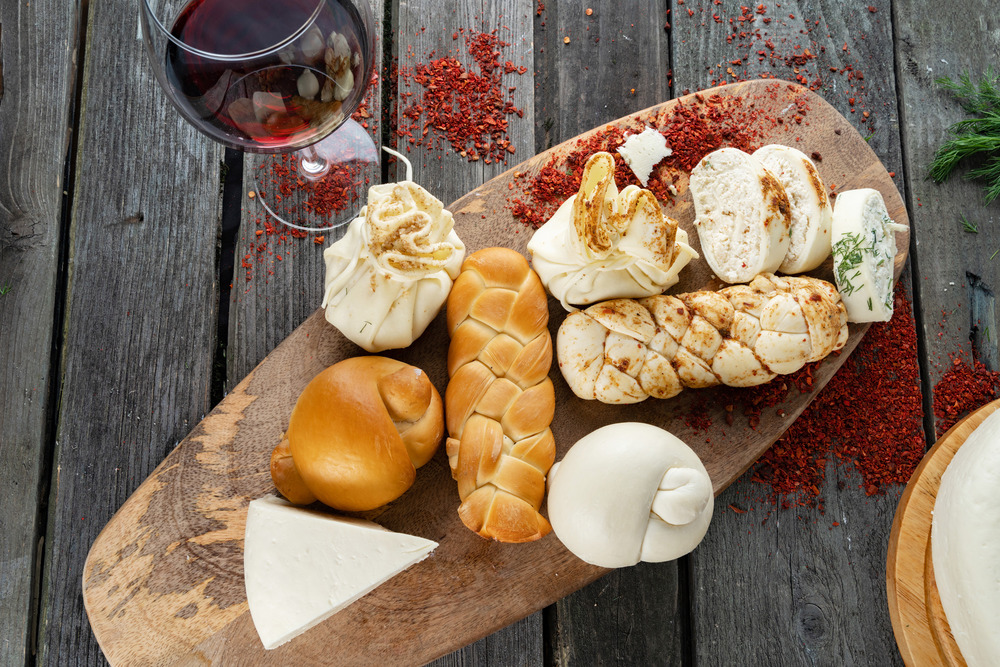
It is not a city dish. It is an invention of the mountain residents. The best Khinkali is prepared in mountainous Khevsureti, Pshavi and Tusheti. Khinkali is the main dish at every feast in these mountainous regions. All the women of the village have to prepare Khinkali together, as it requires a hard and assiduous preparation. Meanwhile men take care of the fire and huge vat full of Khinkali to avoid overcooking. As for famous Khevsureti or Tusheti beer, it should already be prepared by that time.
Don’t forget the delicious Mtsvadi, meat grilled to perfection over a vine-wood fire; Ajika, the devil’s own spicy, hot sauce and Churchkhela and Pelamushi, little luxuries made of grape juice and flour prepared just at the end of grape harvest-Rtveli. Churchkhela and Pelamushi come originally from Kakheti region.
Food in Kakheti is just as guileless as the Kakhetians themselves. They will invite you into their houses only once and if you refuse this invitation even if only out of courtesy, do not expect to be invite again. You should not be surprised when Kakhetian leads his/her guest to the wine cellar first and then into the house. Kakhetians like to boast on their wine that is kept in the huge clay jugs down in the cellar. He will surely tell you the age and type of the wine he had made himself. Then he will let you taste his wine from a clay cup, however only after the toast has been pronounced. That’s when the hostess comes down with flat prolonged bread Lavashi baked in the special oven (Tone) and ovine cheese.
And these are only some of the treats waiting at the Georgian feast or ‘Supra’
There is nothing we can say about the Georgian cuisine, but our sincere advice would be: try yourself and don’t forget to enjoy with it.
Georgian Folklore
Be witness to the hovering men and women, unique steps and dizzying dance moves, that tell stories of war, love and friendship-your introduction to Georgian dances! Captivated spectators are left breathless watching the stunning performances and call for an encore with thunderous applauses. The magical sensation fills the theater, uniting thus, spectators and dancers into participants in this one big celebration. These dances performed today have been enacted for centuries. Georgian folk songs are also incredibly melodic. Stories are narrated through music. As a matter of fact, Georgian polyphonic singing has been proclaimed by UNESCO Intangible Cultural Heritage. Here we have to mention, that in 1977 “Chakrulo”,-a Georgian folk song, was included in the Golden Records sent into space on the Voyager
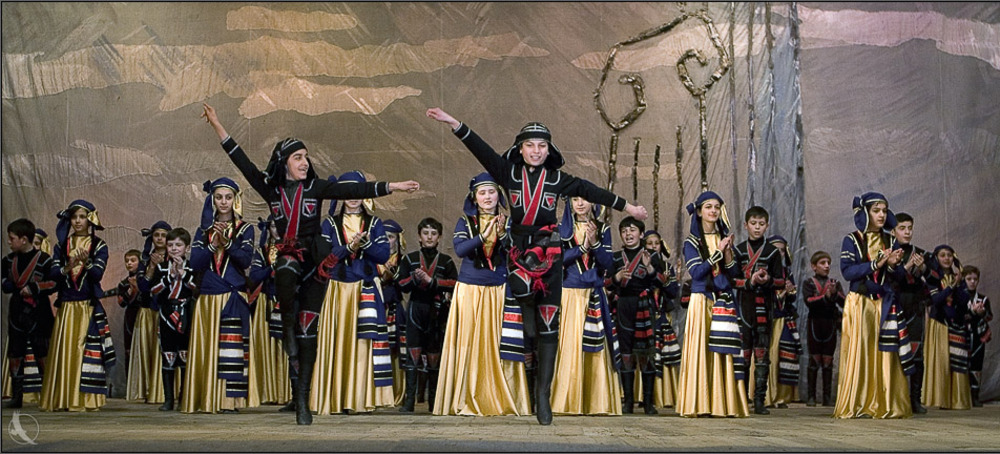
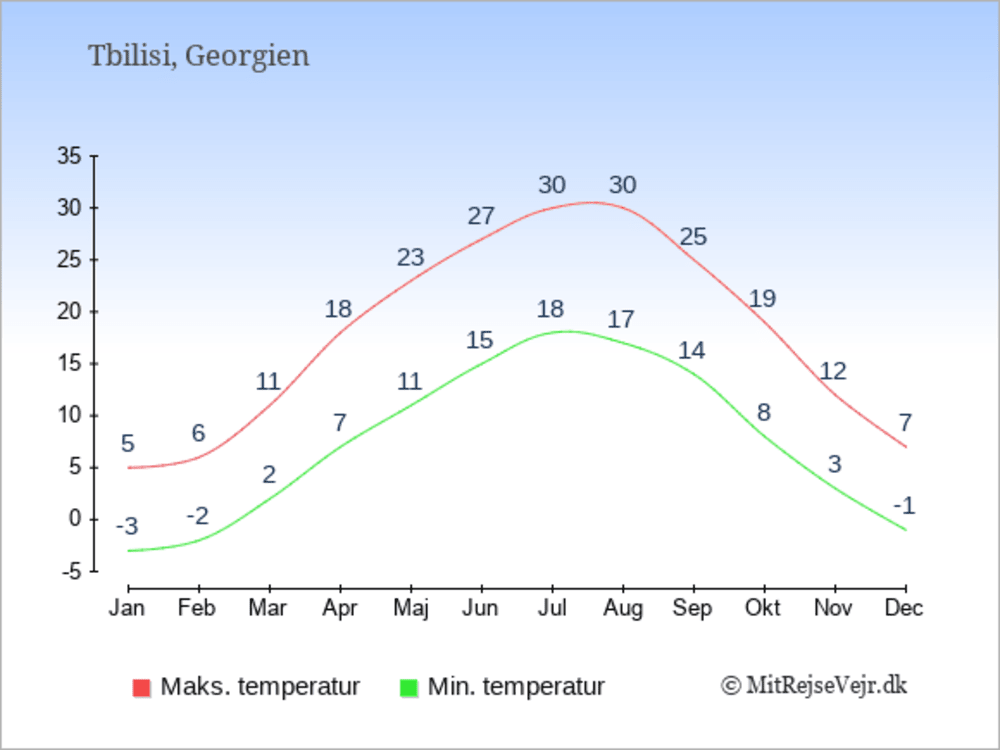
Climate
A comparatively small territory of the country demonstrates almost a complete variety of the climate zones of the planet-from eternal snows and glaciers, High Mountain zones of the Caucasus Major-to the humid subtropical climate of the Black Sea coast, and from the climate of tropics-to that of the semi-deserts. The Likhi mountain range divides the country into two sharply different climate areas: the humid subtropical western zone of the Black Sea, and the dry continental zone of the east. The Greater Caucasus Mountain Range plays an important role in moderating Georgia’s climate and protects the nation from the penetration of colder air masses from the north. The lesser Caucasus Mountains partially protect the region from the influence of dry and hot air masses from the south as well.
The average temperature is January is about +3 O in the Western Georgia and -2 O in the Eastern part; correspondingly, the temperature varies in August within the limits of 23-26 O c.
On the mountain slopes of Georgia, average temperature of July goes as low as +4 O c, +6 O c. In the high mountains average temperature of January can reach -10 O C, -16O C.
The weather in the mountains is often changeable. Sudden cold snaps are accompanied by strong snowfalls, downpours and hails. The regions that lie above 2,000 meters (6,562ft), frequently experience frost even during the summer months.











